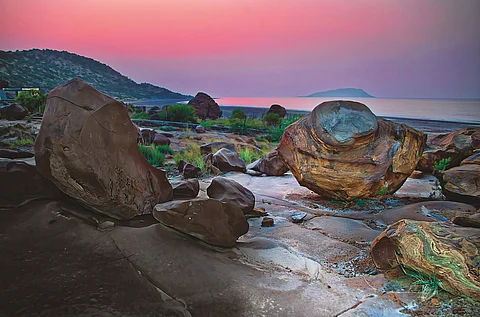
- Destinations
- Experiences
- Stay
- What's new
- Editor’s Picks
- Responsible Tourism
- CampaignsCampaigns
- Subscribe

In the north-western coast of our land, where the lion&rsquos jaw of India thrusts aggressively into the Arabian Sea, there is a city. It was built thousands of years ago by unknown people, sailing in from an unknown place. They brought with them incredible technical skills of urban planning, water harvesting, metallurgy and an unflinching civic discipline.
Then they abandoned their city and vanished. The saline sands of the Rann of Kutch covered it. To our good fortune, it was discovered by the historical pioneers of our Archaeological Survey of India (ASI)&mdashand we became aware of Dholavira.
Very little rain falls in this arid area, and even that deluges in a short burst and is carried away by seasonal, rushing torrents. Using incredible water-harvesting skills, the unknown, ancient, immigrants tapped every drop and diverted it into large, water-tight reservoirs. Wedge-shaped bricks increased the storage tanks&rsquo water-tight integrity. The reservoirs were accessed by flights of steps and could have been the models for the stepwells of Gujarat.
Civic responsibilities were rigidly adhered to&mdashfrom water-borne sanitation in every house to the street corners of buildings being indented to prevent damage by bullock-drawn vehicles, to the division of the city into rising tiers separated by retaining walls. It was, as most of our societies are, a class-divided structure with manual workers at the lowest segment, rising through their supervisors, bureaucrats and executives to the bosses at the pinnacle. It also had an enormous public stadium right at the top. We believe that the much-touted &lsquoworld&rsquos first street sign&rsquo was not written in their script but was inscribed in pictograms like our airport signs.
It is more than likely that the Dholavirans set up their export-oriented, industrial city close to the source of their raw materials sea-shells, semi-precious stones polished by the sea, copper, clay and firewood. Their trademark seals have been found in Mesopotamia, and we have seen a bead pierced with a hole so small that only a human hair could pass through it.
This was an industrial, export-oriented civilisation with all its impressive factories, furnaces, foundries and kilns belching smoke across the wetlands of the Rann and away from the city. Dholavira&rsquos appetite for wood was insatiable. When the wetland forests had been consumed and piles of ash had built up, fresh water gave way to salinity.
Dholavira was choked by its own efficiency and by its inability to realise that its once-sacrosanct old ways, its set-in-stone cultural patterns, its revered sanskriti, provided no solutions to modern problems.
For us, Dholavira is not only the most intriguing archaeological site in our land, it also holds a number of messages which could, collectively, upset the traditional belief on which many of us base our most cherished presumptions. These questions are likely to get a new life because, at long last, UNESCO has placed Dholavira on its World Heritage List. Here are a few of the possible queries.
Questions are the lifeblood of scientific enquiry as they are of political dialogue. In fact, they are the essence of any dialogue. As Gautama Buddha said, &ldquoQuestion everything. Even what I say.&rdquo
That is an excellent point to end this column.
